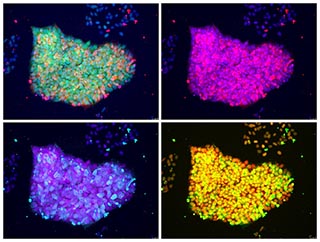
Discussed in this course are pluripotent stem cells, which are undifferentiated cells that maintain the capability to give rise to any cell type. These Induced Pluripotent Stem Cells (iPSCs) are adult cells that have been genetically reprogrammed to an embryonic stem cell–like state, and the different colors indicate different genetic markers being expressed by the cells. Image by Sabrina Heman-Ackah, niams nih on flickr. License BY-NC-SA.
Instructor(s)
Dr. Laura Blanton
MIT Course Number
7.342
As Taught In
Fall 2017
Level
Undergraduate
Course Description
Course Features
Course Description
In this course, we will explore how animals determine and maintain cell fate. We will discuss changes to DNA structure and packaging, special proteins (known as "master regulators") with the ability to alter cell fate via transcription, cell-cell signaling, and RNA localization.
This course is one of many Advanced Undergraduate Seminars offered by the Biology Department at MIT. These seminars are tailored for students with an interest in using primary research literature to discuss and learn about current biological research in a highly interactive setting. Many instructors of the Advanced Undergraduate Seminars are postdoctoral scientists with a strong interest in teaching.


